Key takeaways:
- Creating inclusive events requires careful attention to accessibility, representation, and participant empowerment to ensure all voices are valued and heard.
- Diverse formats and collaboration with local organizations can enhance engagement and bring fresh perspectives to discussions, especially in anti-war activism.
- Feedback and observation are essential for assessing inclusivity; implementing changes based on participants’ experiences fosters a sense of belonging and deeper engagement.
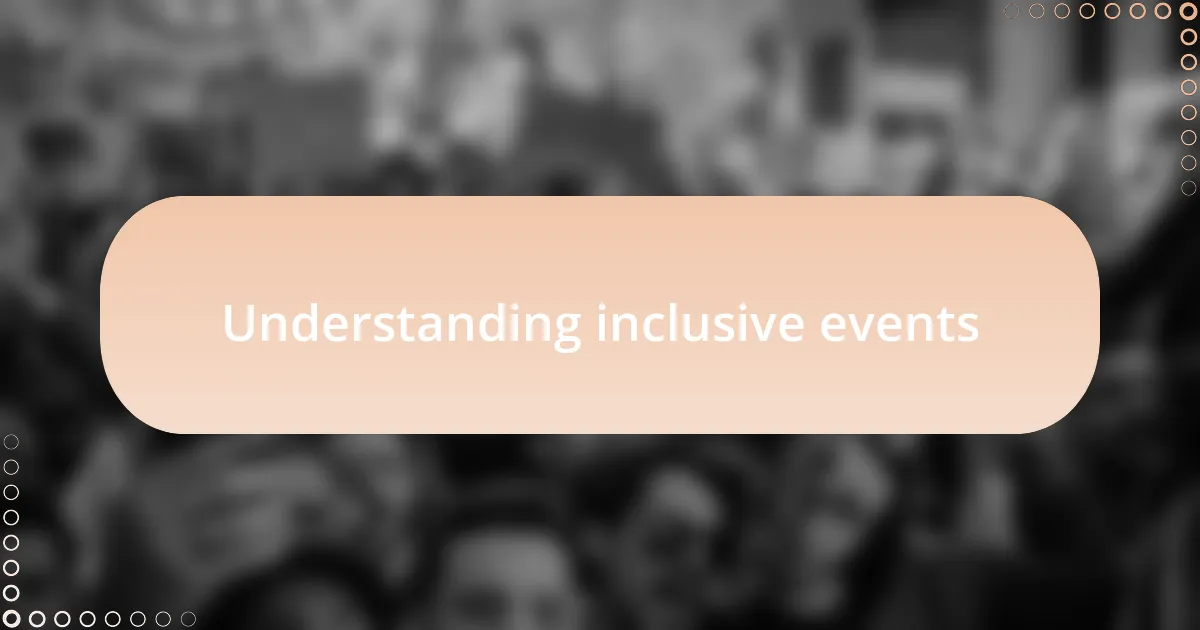
Understanding inclusive events
Inclusive events are about creating spaces where everyone feels welcomed and valued. I recall attending a community gathering where the organizers made a conscious effort to involve people from diverse backgrounds. It wasn’t just about being physically present; it was about ensuring that voices from different cultures and perspectives were heard and appreciated.
Have you ever considered how the smallest details can foster inclusivity? For example, at one event, there were materials available in multiple languages, which made non-native speakers feel more comfortable participating. This thoughtful approach can transform an event from simply being a gathering to a true community experience.
Moreover, inclusivity extends beyond representation—it’s about access. I remember feeling frustrated at events where nothing was done to accommodate individuals with disabilities. By prioritizing accessibility, we can ensure that everyone, regardless of their circumstances, has the chance to engage fully. How does it feel to be excluded? It’s often a stark reminder of how vital inclusive practices are to meaningful activism.
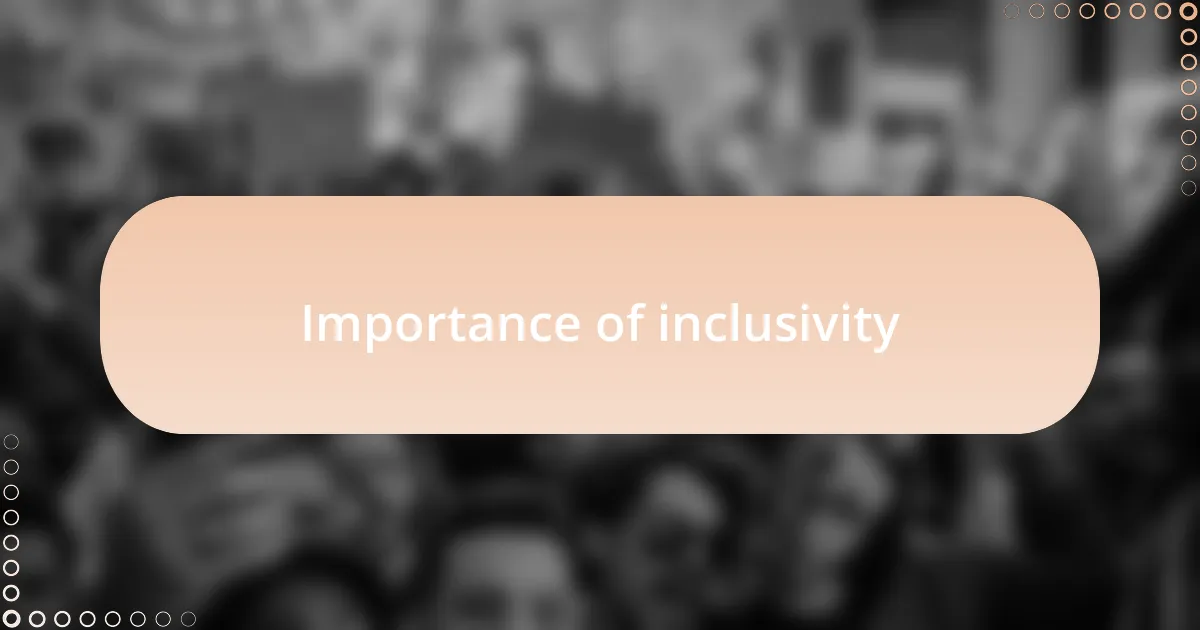
Importance of inclusivity
Inclusivity is not just an ideal; it’s essential for creating effective anti-war activism. When I think back to an event where diverse voices were elevated, I noticed how much richer the discussions became. It was eye-opening to see how individuals with different experiences contributed unique perspectives that challenged our assumptions and inspired collective action.
Have you ever felt the weight of exclusion? I certainly have. There was a protest I attended where a key speaker of a marginalized community was sidelined. The energy shifted; it was clear that without their voice, we all lost something vital. This moment underscored the importance of ensuring that every group feels represented, as their input can lead to more impactful solutions.
The beauty of inclusivity lies in its ability to create a tapestry of ideas. In another gathering, I witnessed participants collaborate in ways I had never anticipated, simply because everyone was invited to share. This synergy not only enhances creativity but also fosters a sense of belonging, making every individual feel invested in the cause. Don’t you think that when people feel included, they are more likely to engage and advocate for one another?
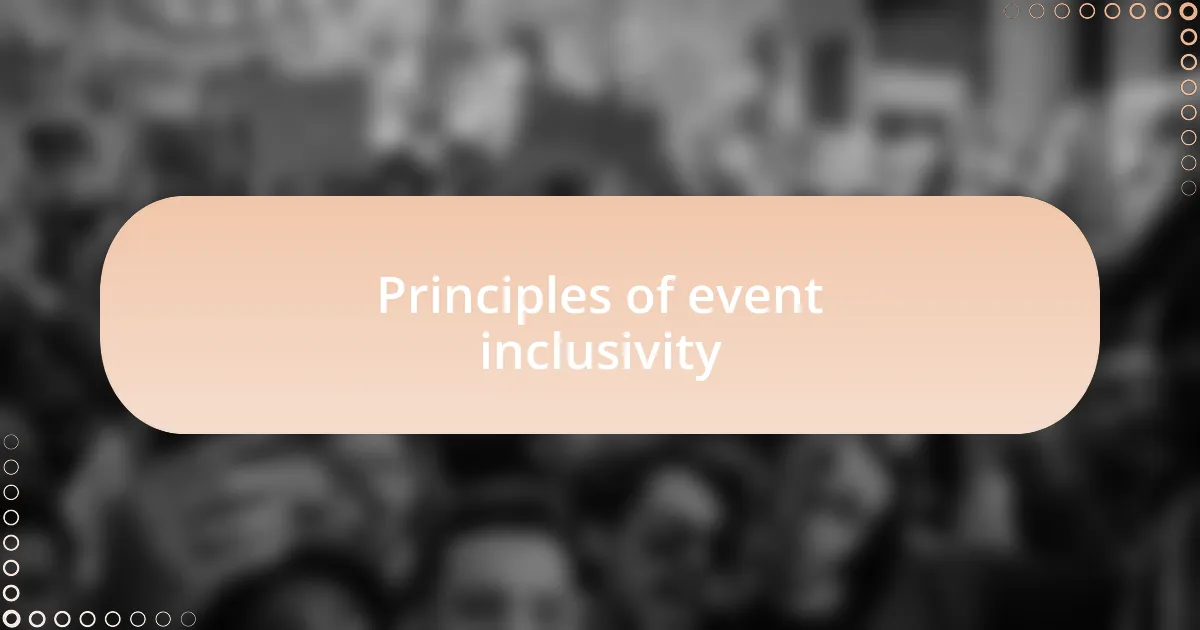
Principles of event inclusivity
Inclusivity starts with acknowledging the diverse backgrounds and experiences of participants. At one event, I remember a simple yet profound moment when attendees were asked to introduce themselves and share why the anti-war movement mattered to them. This exercise broke the ice and immediately created an environment where everyone felt valued. Have you ever noticed how much deeper conversations become when people share their stories? It’s a reminder that inclusivity isn’t about just filling seats; it’s about ensuring every voice is heard and respected.
Another guiding principle is accessibility. I once attended a rally that, unfortunately, wasn’t fully accessible. It was disheartening to see some voices excluded because of physical barriers. This experience taught me that a truly inclusive event must cater to everyone’s needs, from wheelchair access to providing materials in different languages. Aren’t we missing out on critical insights when we overlook practical elements like these? Every detail counts in fostering an environment that invites all to participate.
Lastly, giving power to participants can transform an event. At one gathering, I suggested holding small breakout discussions instead of a single speaker-led session. The change made a world of difference; people who usually stayed quiet became animated contributors. It reinforced my belief that inclusivity is about more than just representation—it’s about empowering everyone to take part in shaping discussions. Don’t you think that when people have agency, they’re more likely to feel passionate about the cause and commit to change?

Strategies for anti-war event planning
One effective strategy for anti-war event planning is to integrate diverse formats into your agenda. I once organized a community gathering that featured not just speeches, but also art displays, poetry readings, and interactive workshops. This variety captured the attention of different participants and encouraged more dynamic interactions. Have you ever noticed how some people might feel intimidated by traditional lecture formats? By diversifying the formats, we opened up opportunities for everyone to express themselves in a way that felt comfortable.
Collaborating with local organizations can also amplify your event’s reach and impact. In my experience, partnering with a local youth group for an anti-war forum brought in fresh perspectives that resonated with younger attendees. Their voices added vital energy and urgency to the discussions. Don’t you think that when we tap into the passion of local communities, we create a more vibrant and engaging dialogue?
Lastly, consider the role of follow-up in event planning. After an anti-war rally I helped organize, we created a shared online platform for attendees to continue the conversation. This space allowed for ongoing dialogue and connected people beyond the event. Isn’t it essential to keep the momentum going? By fostering connections post-event, we encourage deeper alliances and sustained commitment to the cause.
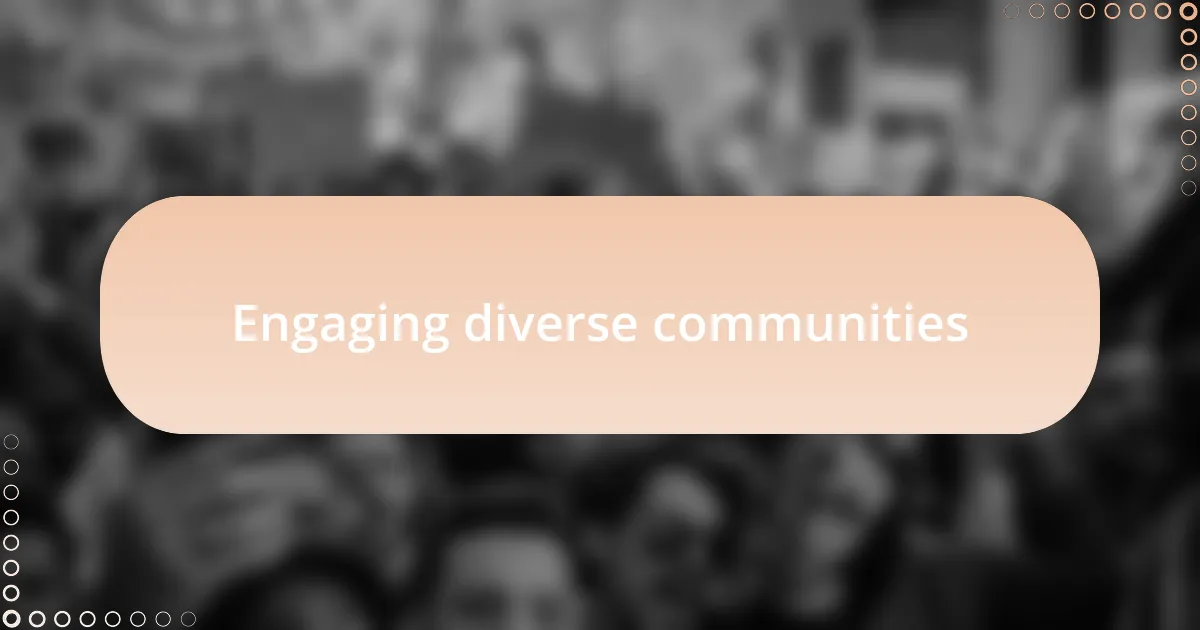
Engaging diverse communities
Engaging diverse communities requires a deep understanding of cultural nuances and values. I remember a community dialogue event where we invited speakers from various cultural backgrounds. Each story shared was a window into different experiences with war, and I was captivated by how personal narratives can resonate across cultural divides. Have you ever thought about how storytelling can unify us, even in our differences?
Additionally, I’ve found that leveraging multiple languages can break down barriers and foster inclusivity. At one event, we provided interpretation services, which made attendees feel valued and heard. It was powerful to see how excited people were when they could participate fully in discussions without language constraints. This experience taught me that when we make our events accessible, we invite a richer tapestry of voices to contribute.
Finally, engaging with diverse communities also means recognizing and addressing the specific issues they face. I once hosted a workshop specifically for marginalized groups to discuss how anti-war activism intersects with their struggles. The insights shared in that space were profound, and it underscored for me that activism is not a one-size-fits-all approach. Have you reflected on how tailored conversations can drive more significant change within specific communities?
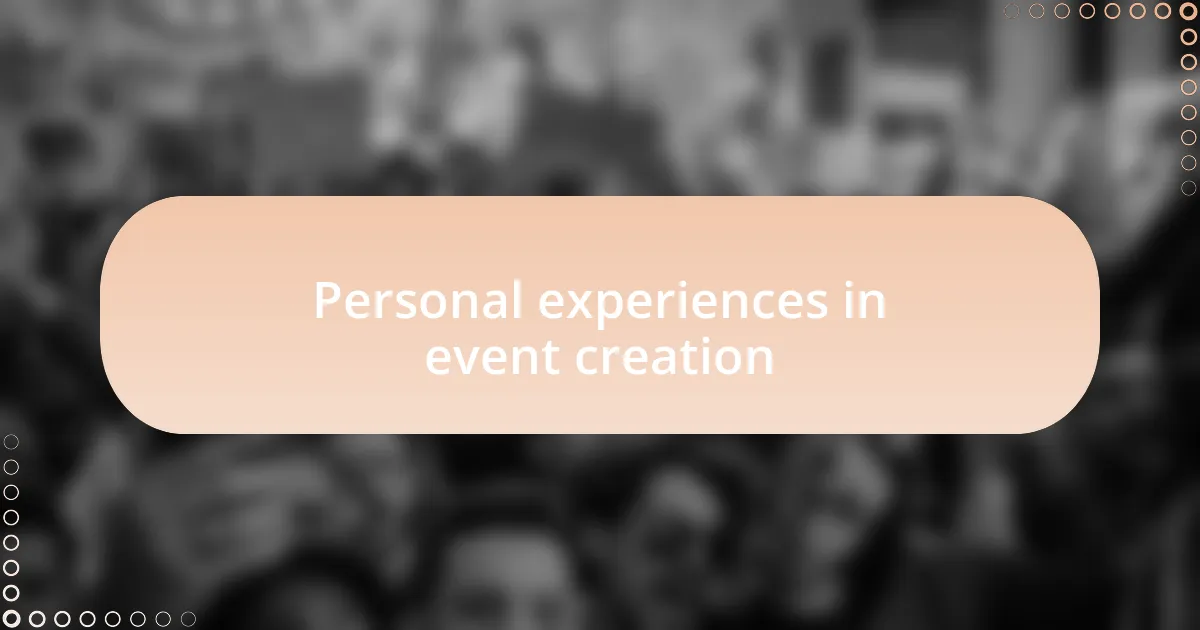
Personal experiences in event creation
Creating inclusive events has taught me so much about the power of collaboration. At one point, I partnered with local organizations that represented different communities. The experience was eye-opening; their insights fundamentally shaped the event’s agenda and format, making it more relevant to the attendees. It made me realize: how often do we truly invite others to co-create rather than just participate?
One particular event stands out to me. I organized a peace march where we not only invited speakers but also encouraged poetry submissions from the community. Seeing the pride on people’s faces as they read their work was unforgettable. It struck me that inclusivity can flourish when individuals feel personally connected to the cause—why not let everyone’s voice be part of the narrative?
I also learned that logistics play a huge role in ensuring an event is welcoming. I once overlooked the need for wheelchair access until I received feedback from an attendee who shared how being left out of the conversation affected them. That moment humbled me; it was a stark reminder that inclusion means considering every aspect of the event experience. Have you ever thought about how the smallest details can either create or undermine a welcoming atmosphere?
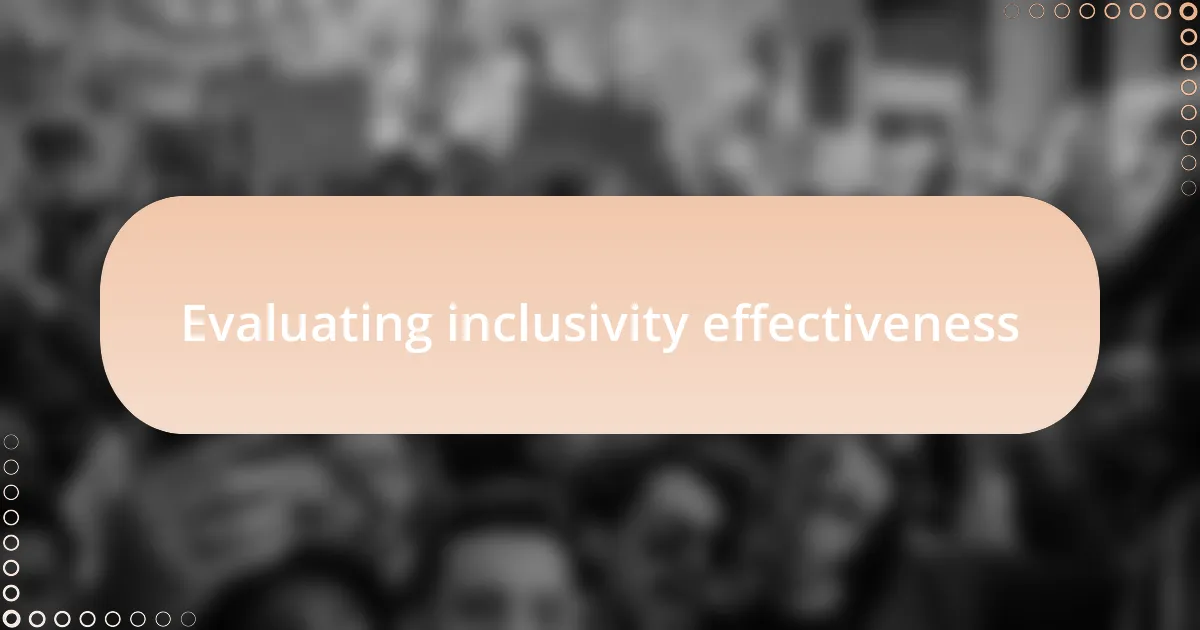
Evaluating inclusivity effectiveness
When assessing the effectiveness of inclusivity in events, I’ve found that feedback is invaluable. After one event, I created a simple survey for attendees that asked how well they felt represented. The candid responses ranged from joyful affirmations to poignant critiques, reminding me that it’s essential to continuously refine our approach. Have you ever wondered how much we can learn from simply asking for opinions?
It’s crucial to go beyond just collecting feedback; I often implement changes based on what I hear. For instance, after receiving comments about needing more diverse representation on a panel, I made it a priority to include voices from various backgrounds in future discussions. This shift not only enriched the conversation but also created a sense of belonging among attendees. Can you recall a time when a change made you feel more included?
I’ve also realized the power of observation during events. Watching interactions can reveal unspoken barriers that surveys might miss. At one gathering, I noticed some groups formed along familiar lines, which pointed to a lack of engagement across different communities. This insight led me to design more interactive activities that promoted cross-group discussions. Isn’t it fascinating how much we can discover just by being present?